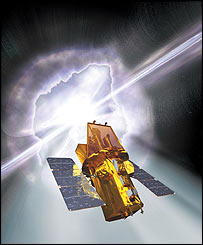The Helvin Swift has finished the period of experiments and calibration

The Swift space observatory, which is supposed to uncover the mysteries of some of the biggest explosions in the universe, went into full operation on Tuesday. The satellite devices have undergone tests and calibrations since the launch last November. Now the observatory, which cost 250 million dollars, received permission to begin its mission and upload scientific data to the public Internet. The researchers will perform data mining to try to explain what exactly happened in the explosions and collapses of distant stars.
Swift is designed to capture the signals coming from gamma-ray sources that first signal such events, then Swift will directly observe the flash using X-rays and ultraviolet rays, as well as direct visible-light telescopes to this source. The longer wavelength flash echoes can last for days and Swift will alert ground-based telescopes to join the observation.
"We are talking about the creation of black holes, for example, and the physics there is very, very extreme," says Dr. Julian Osborne from the University of Leicester in the UK to the BBC. "These are the brightest explosions in the universe since the Big Bang. We are talking about relativistic explosions at a speed of 99.999% of the speed of light. This is a field that is inaccessible in any other way. Swift is a spectacular instrument," he explained at the British National Astronomical Conference in Birmingham.
Swift actually includes two instruments, the Burst Alert Telescope, built by NASA's Goddard Center, will detect and locate about two gamma-ray bursts per week and transmit their location to the ground with an accuracy of one arc minute to four arc minutes in about twenty seconds. The location it finds will be used to orient the satellite to the eruption, to study the afterglow with an X-ray telescope (XRT) and an ultraviolet and visible light telescope (UVOT).
These two longer-wavelength (and lower-energy) telescopes will determine the location of the outburst with arcsecond accuracy and also the spectrum of its trailing glow in the wavelength range from visible light to X-rays. For most of the eruptions, the Swift will detect, the data obtained in combination with data from telescopes on Earth will allow the measurement of the redshift, or the distance, to the origin of the eruption. The afterglow provides vital information about the dynamics of the outburst, but scientists need precise information about the outburst to detect the afterglow.
Swift will spread its message to the community, which includes both museums and the general public as well as scientists at respected observatories, through the Gamma-ray Burst Landmark Network (GCN), maintained by the Goddard Center. A whole network of special robotic telescopes for this mission, scattered around the Earth, will watch for messages from the Swift-CGN network.
A continuous stream of information about outbursts will flow through Swift's Mission Control Center, located at the University of Pennsylvania. The University of Pennsylvania, an important partner from the United States, built the XRT telescope in collaboration with the University of Leicester in England and the Brera Astronomical Observatory from Italy. The UVOT telescope was built by the University of Pennsylvania in collaboration with the Mullard Space Science Laboratory from England.
